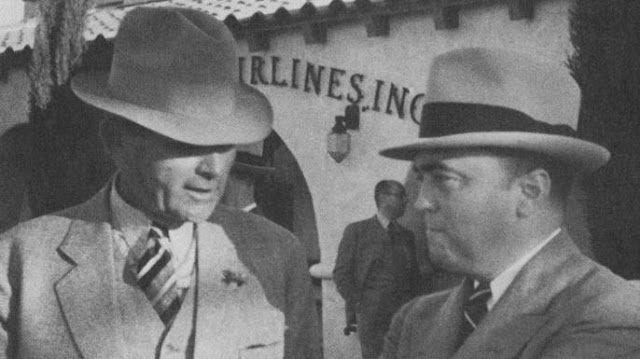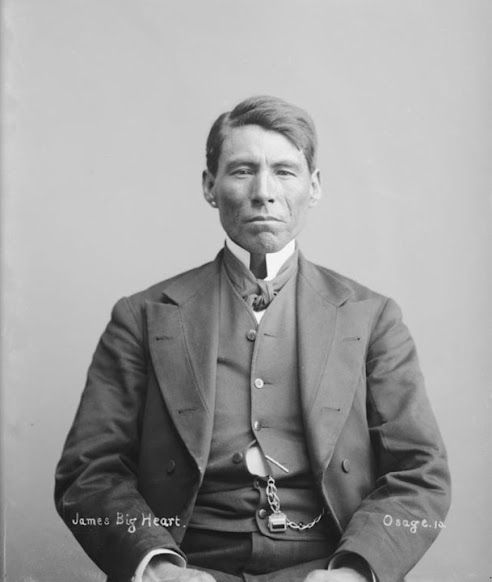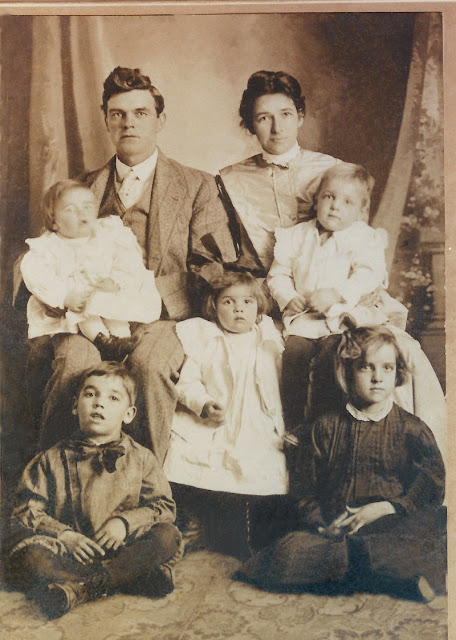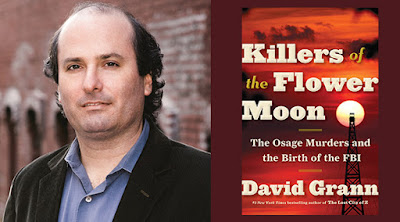With a
title like Killers of the Flower Moon: the Osage Murders and the Birth of the FBI,
all that's left to tell, when you think about it, are the details.
But, oh mercy, those details.
It's a
tragically true story peppered with fiction:
the
lies one race of people consistently told another race. And we
already know which was the lying race, considering we're looking once
again at our history of "forked tongue" in the conquering
and settling of the American West by a land-hungry nation of
Bible-toting fortune seekers. We already know plenty of blood was
spilled by both races in this struggle between appetite and survival.
This book rips away the fig leaf of public innocence that concealed
just how catastrophically evil the hungry ones became when they
deemed Oklahoma's Osage Indians nothing more than speed bumps in the
stampede to the feeding trough.
During a
sixteen-year period (1907-23) Osage County Indians were dying at
nearly twice the national rate, many of them suspiciously and some
obviously murdered. When state, local and private investigators
failed to solve any of the obvious murders, the infant FBI—then
known only as the Bureau of Investigation and directed by a shady
former private detective—took a look, and got nowhere. Then J.
Edgar Hoover became director. Hoover assigned Special Agent Tom
White, a former Texas Ranger with an exemplary reputation, to revisit
the failed investigations. The result led to the conviction of an
important white resident of the county and several henchmen.
More
recently, in 1992, Dennis
McAuliffe Jr., a
Washington
Post
editor and grandson of another Osage Indian whose death had been
suspicious, looked deeper and concluded that many more Indians than
initially thought most likely were murdered. McAuliffe’s
work was followed by David Grann, the New
Yorker
staff writer who researched and authored this book, Killers
of the Flower Moon. Grann
dug even deeper, and found how incomprehensibly horrible the “Reign
of Terror” in Osage County actually had been.
 |
| Special Agent Tom White and Boss |
 |
| Dennis McAuliffe |
Grann
quotes Garrick Bailey, a leading anthropologist on Osage culture, as
saying he believed “a high percentage of the county’s leading
citizens” were behind the killings. “Indeed,” Grann concludes,
“virtually every element of society was complicit.” One of the
victims was Barney McBride, a wealthy white oilman who was shot to
death in Washington where he’d gone carrying an appeal by the Indians
for a federal investigation. McBride, Grann says, “threatened to
bring down...a vast criminal operation that was reaping millions and
millions of dollars.”
Ah, finally, a clue to the motive besides
“the only good injun is a dead injun.”
Oil!
An
underground sea of the “black gold” lay under land the Osage
ended up owning after more than a century of U.S. treachery
(including that of Pres. Thomas Jefferson). The government might have
gotten hold of the oil as well as the nearly hundred million acres of
Osage ancestral land had it not been for tough Indian bargaining led
by Chief James Big Heart,
who spoke seven languages, including Sioux, French, English, and
Latin, and John Palmer, a lawyer whose mom was Osage. Buying their
reservation allotment the Osage managed to include in the transaction
that “the oil, gas, coal, or other minerals covered by the lands…
are hereby reserved to the Osage Tribe.” The Indians knew somehow,
Grann writes, their reservation rested upon oil deposits.
 |
| Chief Big Heart |
According
to the allotment provisions, the Osage would own the mineral rights
even after selling their land. Each tribe member received what was
called a “headright,” which could not be sold, and was passed
down through the generations.
Well, lo
and behold, prospectors “discovered” the oil, and Indians owning
these headrights now were entitled to quarterly royalties from its
commercial sale. Suddenly the Osage were rich, and suddenly Osage
maidens were more attractive than ever to white men who wanted to
marry them. And marry them they did, and everyone might have lived
happily ever after, but…
There was a catch. Naturally.
Whoever first suggested that women always get the last word evidently
overlooked the U.S. Congress. Responding to popular concern about the
potential for irresponsible spending by the Osage of their new-found
wealth, the lawmakers decreed that “guardians” be appointed to
oversee this spending. The guardians, of course, were white.
One white
with good intentions, W. W. Vaughan, an attorney and former
prosecutor who vowed to eliminate the criminal element that was a
“parasite upon those who make their living by honest means,” was
murdered and thrown from the train he was taking home from Oklahoma
City after visiting the dying Chief Big Heart,
who’d been poisoned.
“The
justice of the peace was asked by a prosecutor if he thought that
Vaughan had known too much.” Grann says. “The justice replied,
‘Yes, sir, and had valuable papers on his person.’”
 |
| W.W. Vaughan and family |
Are we
catching the drift here? Do we pick up a whiff of stink learning that
Indians with headrights or in line to inherit them begin dying
mysteriously, perhaps from poison, or from solidified lead propelled
by gunpowder? Or, as in one case, when their home explodes to
smithereens in the middle of the night while they’re in bed asleep?
Read Killers
of the Flower Moon
and the stench will gag you.
You might wonder, knowing this
overpowering circumstantial evidence, why the local justice system in
Osage County couldn’t come up with any solid evidence. Understandably, forensic science was barely existent then—even
after the fledgling FBI got involved—and witnesses might be reluctant to testify, not knowing who if anyone in
their community they could trust.
“The
murders had created a climate of terror that ate at the community,”
according to Grann. “People suspected neighbors, suspected friends.
“A
visitor...later recalled that people were overcome by
‘paralyzing fear,’ and a reporter observed that a ‘dark cloak
of mystery and dread…covered the oil-bespattered valleys of the
Osage hills.’”
Grann writes, “All efforts
to solve the mystery had faltered. Because of anonymous threats, the
justice of the peace was forced to stop convening inquests into the
latest murders. He was so terrified that merely to discuss the cases,
he would retreat into a back room and bolt the door. The new county
sheriff dropped even a pretense of investigating the crimes. ‘I
didn’t want to get mixed up in it,’ he later admitted, adding
cryptically, ‘There is an undercurrent like a spring at the head of
the hollow. Now there is no spring, it is gone dry, but it is broke
way down to the bottom.’
“Of
solving the cases, he said, ‘It is a big doings and the sheriff and
a few men couldn’t do it. It takes the government to do it.’”
“The
world’s richest people per capita were becoming the world’s most
murdered,” Grann sums up. “The press later described the killings
as being as ‘dark and sordid as any murder story of the century’
and the ‘bloodiest chapter in American crime history.’”
[For
more Friday's Forgotten Books check the links on Patti
Abbott's unforgettable blog]

Outstanding summary and review. This book is as extraordinary as it is horrific. A grisly chapter in American history. Alas, many of the mysteries will never be solved.
ReplyDeleteI bought this last year and STILL haven't read it. I'll have to dig it out of the box and get to it this month. He won the Edgar for Best True Crime...of course.
ReplyDeleteIf you like this kind of history you ought to try another true crime book written by Bill James -- a sports writer no less -- in which he and his daughter turn research detectives and find reasons to tie together a series of murders committed over a fifteen year period to one man. It's called The Man from the Train: The Solving of a Century-Old Serial Killer Mystery. Truly an amazing feat of detective work by amateurs armed only with internet search engines and access to ancient newspaper archives. The writing itself, however, I find slipshod in its mix of good reporting and an intrusive overly chatty tone where he directly addresses the reader. Apparently he went through many editors who left him when James refused to adapt a more professional and consistent journalistic style. This is alluded to in his acknowledgment page at the end of the book. You can definitely read between the lines of his thanking all his editors after having endured all his "I'll get to this later" and "You know what? That's right..." nonsense.
Another depressing post (and scary), Mathew, but I am glad that you covered this book and these crimes.
ReplyDeleteI'd heard about this book and decided NOT to read it though I love David Grann's work, Mathew. I knew if I read it I would get too upset and added to my daily upset over what is currently happening in this country of ours, I thought I'd better not. It sounds devastating. Our history is so blood-splattered.
ReplyDeleteThank you for the kind words, friends. I just learned from blogging buddy John Norris that evidently Blogger's notification system is on the blink for comment moderation. I went to comment moderation about a month ago after receiving an obscene spam comment, but now, as has John, I'm going back to open comments. It will be easier to delete the occasional spam than to worry about missing comments from friendly readers.
ReplyDeleteI saw your comments about the weird thing Blogger has done with not sending notifications anymore, Matt. That caused some problems for me also until I realized what was going on.
ReplyDeleteMaybe the spammers have have hacked Blogger!
Delete